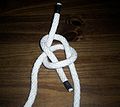Knots/Loop knots/Bowline

The bowline (bow-linn) is an ancient but simple knot used to form a fixed loop at the end of a rope. The structure of the bowline is identical to that of the sheet bend, except the bowline forms a loop in one rope and the sheet bend joins two ropes. Along with the sheet bend and the clove hitch, is often considered one of the most essential knots.
The name has an earlier meaning, dating to the age of sail. On a square-rigged ship, a bowline (sometimes spelled as two words, bow line) is a rope that holds the edge of a square sail towards the bow of the ship and into the wind, preventing it from being taken aback. A ship is said to be on a "taut bowline" when these lines are made as taut as possible in order to sail close-hauled to the wind.
Usage
[edit | edit source]
The bowline is used mainly to make a temporary loop at the end of a line. Like the other similar knots, it can be made and then secured over an object like a post. Since the bowline is generally tied with the working end, it can be passed through a ring or other object before the knot is tied. This feature makes the bowline a convenient and useful loop knot.
The bowline, or more commonly one of its variations such as the double bowline, is sometimes used by climbers to tie the end of the rope to a climbing harness, or the like. The advantage of the bowline in this application is that the knot is easy to untie even after it has been loaded. The disadvantage is that, while it is a very strong knot under load, it has a tendency to loosen up and become untied when it is unloaded and shaken around over a period of time, as might happen during a climb. Several other knots are more commonly used in modern climbing technique.
This knot can be used in an emergency to hoist a person to safety, since the loop can slipped over a victim's torso, under the armpits, and it will not tighten around the victim's chest and prevent breathing. This is useful when a rescue harness is not available.
The bowline is commonly used in sailing small craft, for example to fasten a halyard to the head of a sail or to tie a jib sheet to a clew of a jib.
A rope with a bowline retains about 65% of its strength at the location of the knot.
Tying
[edit | edit source]A mnemonic used to teach the tying of the bowline is to imagine the end of the rope as a rabbit, and where the knot will begin on the standing part, a tree trunk. First a loop is made near the end of the rope, which will act as the rabbit's hole. Then the "rabbit" comes up the hole, around and under the tree, and then back down the hole. When this configuration is tightened, a bowline has been tied. An alternative "lightning method" can also be used.
-
The rabbit hole. (Take note of which end is over which.)
-
Out comes the rabbit,
-
runs around the tree,
-
and hops back into its hole.
-
Lightning method, tied on a ring. Pull per the blue arrows.




